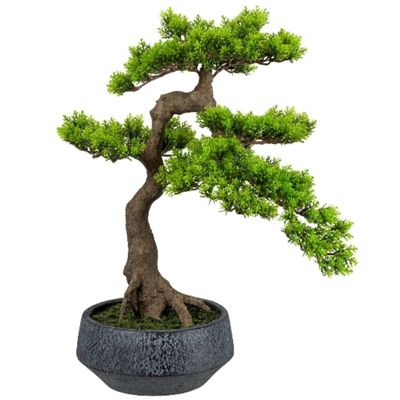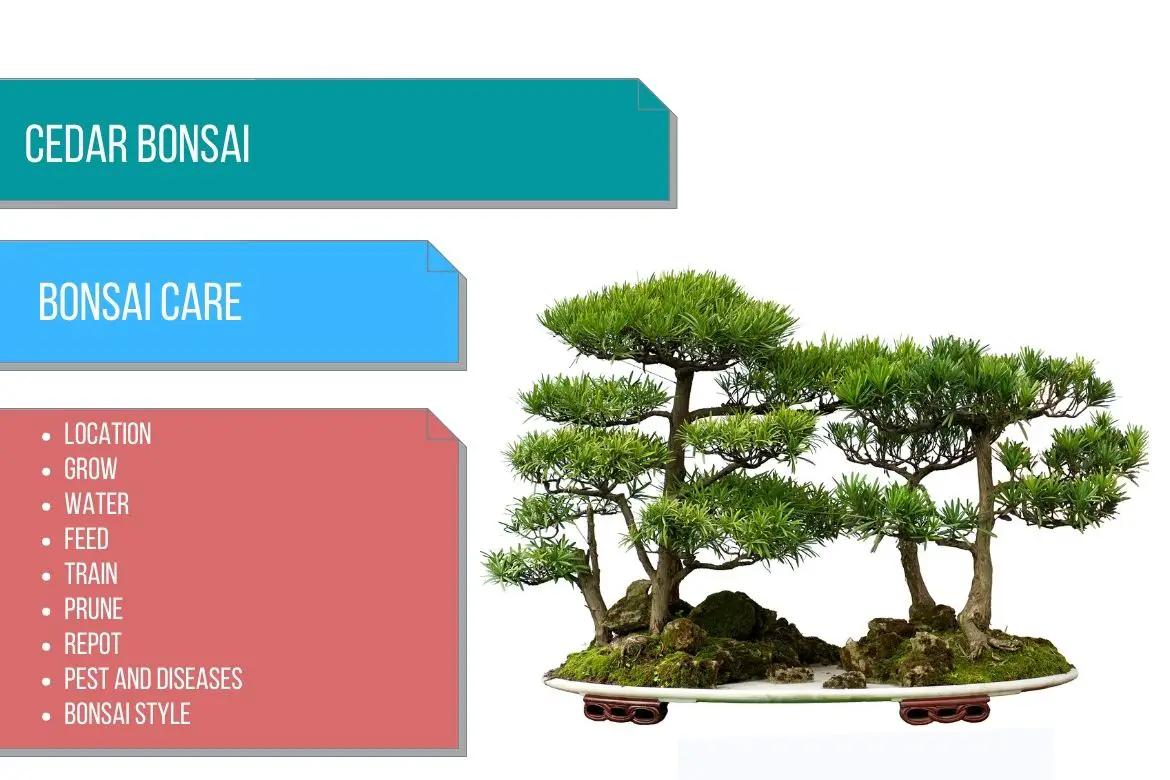
Cedar
(Cedrus)
Country of Origin : Mediterranean and western Himalaya region
Bonsai Styles : Formal upright, informal upright, group, twin trunk
Zone : 6
Cedar bonsai – regardless of the species (four species) you choose – makes a stunning bonsai specimen.
Cedars are impressive and handsome, tall trees. Their evergreen needles are compact and borne in clusters. The needle color varies in differing species (green, dark green, blue).
The trees are easy to train as bonsai in most traditional bonsai styles, and they are quite popular among European and Japanese enthusiasts.
The four species of cedar trees which can also be used to make bonsai are :
- Cedrus atlantica : It is also known as Atlas cedar. It originated from Atlas mountains of Algeria and Morocco. Gray bark, needle-like leaves, and cylindrical cones distinguish this evergreen conifer.
It also has a sub species known as Cedrus atlantica ‘glauca‘ (known as blue cedar). This
variety has bluish gray colored foliage and paler gray bark. - Cedrus brevifolia : It is also known as Cyprian cedar or Cyprus cedar. This is a slow growing cedar variety. It has particularly very short and dark green needle which grow in cluster.
- Cedrus libani : It is also known as Cedar of Lebanon. This species lives relatively longer. Its branches have a horizontal and spreading growth habit. The spreading habit is unique to this species. The needles are dark green in color.
- Cedrus deodara : It is also known as Indian cedar or ‘Deodar’ tree. It has dropping branches. Its leader stem is covered by large needles. The large needles in particular make this species easily distinguishable from other cedar species.
* There is also Japanese cedar bonsai tree (Cryptomeria japonica). However it belongs to a different genus.

Only Cedrus atlantica ‘glauca‘ has blue foliage. Rest of the Cedar species have green foliage color.
Best location to keep Cedar Bonsai
It is possible to keep a cedar bonsai tree in full sun throughout the year.
They are hardy plants in temperate climates and do not require protection in winter. However, young plants should be protected from extreme temperatures. Also, keep the bonsai container safe from freezing winds.
Refer do bonsai trees need sunlight for more indoor and outdoor bonsai location ideas. Also, refer to sunlight requirements for indoor plants for more indoor gardening ideas.
Propagation of Cedar
Cedar tree can be propagated by using softwood cuttings in spring and hardwood cuttings in fall.
They can also be propagated by sowing seeds in spring. You can also perform grafting in late summer.
Watering Cedar Bonsai
Cedar trees are relatively more drought tolerant than their other deciduous cousins. This is because they transpire much less.
It is still important to water regularly (daily) from spring to early fall. As winter approaches, reduce the watering frequency.
Allow the soil to be a little dry to the touch between watering sessions.
Cedar trees do not like wet soil, hence make sure that you do not over water.
Read watering bonsai tree for more details about immersion technique.
Wiring Cedar Bonsai
Cedar bonsai trees can be wired at any time of the year. However, inspect the tree on a regular basis to ensure that the wire is not biting into the tree.
Wires can be left on the tree for about 12 months.
Pruning Cedar Bonsai
When to prune Cedar bonsai?
How to prune Cedar bonsai?
Branches should be pruned back in the spring and fall, cutting branches that are vigorously growing back hard in the fall.
Be careful not to cut through needles when pruning. Prune just above the cluster of needles.

Cutting through the needle will cause browning of the needles or even die-back.
Pinching Cedar Bonsai
Whenever necessary, pinch out new shoot tips with your fingers in spring and summer.
Repotting Cedar Bonsai
When to repot Cedar bonsai?
Cedrus bonsai tree can be repotted every 2-3 years in spring.
When repotting, Cedrus atlantica ‘glauca’ may shed the previous season’s needles due to root disturbance. At the time of repotting, providing the tree with high humidity will prevent the shedding of the needles.
Even if the tree has shed its needles, don’t worry, new buds will emerge soon.
You can use a free-draining, alkaline bonsai soil mix.
OR
You can also make a soil mix with loam, sharp sand and peat (or compost) in the ration of 1:1:1.
Must Read: Bonsai Soil Recipes
Must read : Choosing the right bonsai container
Feeding Cedar Bonsai
The Cedrus bonsai tree will benefit from a light feeding of a high-nitrogen fertilizer in early spring.
Following this, two or three applications of a general fertilizer should be made later in the summer.
Read more about bonsai fertilizer and its application.
Diseases and pest of Cedar Bonsai
Despite being generally trouble-free, cedars are susceptible to honey fungus, which must be treated immediately with a fungicide.
Also, as soon as caterpillars appear, they should be picked off by hand.
Cedar bonsai care
Check the bonsai tree periodically and remove the dead or diseased branches.
Keep the tree away from pets (especially dogs). Keep the tree in a clean and hygienic place so that the chances of rats getting attracted to the tree are reduced.
Cedar bonsai trees should be kept free of unwanted shoots and debris in their inner branches.
By removing dead twigs and debris from the inner section, better light and air circulation will be enabled. It will also prevent red mites from attacking.
What to look for when buying Cedar Bonsai
Bright green leaves are a sign of good health, so look for specimens with them.
Yellow patches on bonsai specimens should be avoided. Also, avoid bonsai specimens with dead or dry foliage.
It is important to look for a cedar bonsai tree that has a distinct trunk structure from the roots to the crown.

